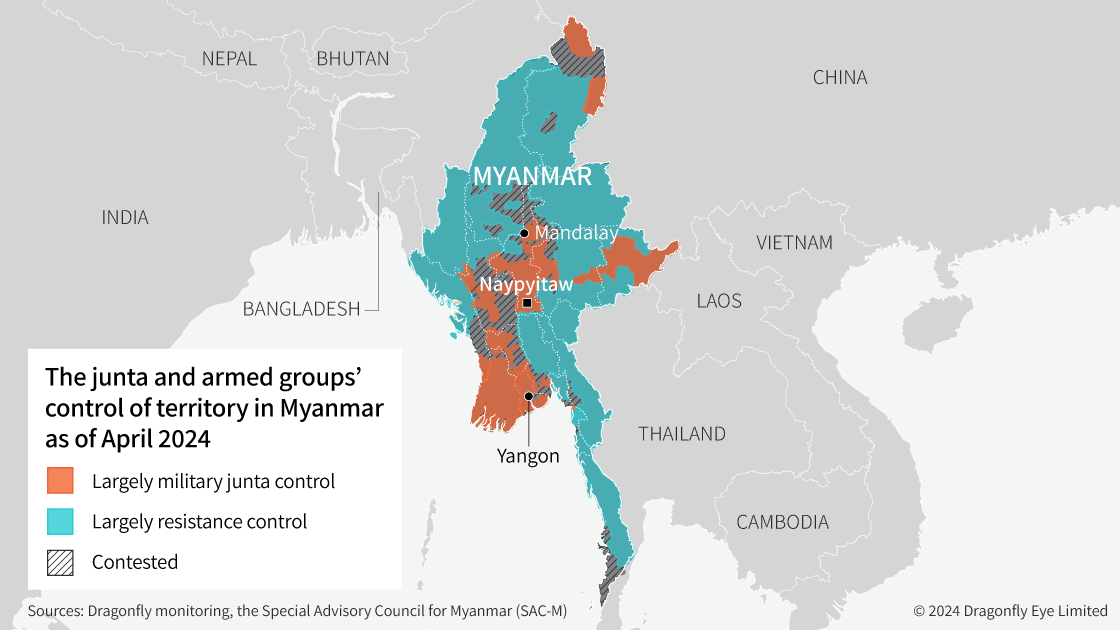Signs of the military’s weakness in Myanmar continue to emerge, with local news reports suggesting that amid offensives by armed groups countrywide, the army is now deploying conscripts with minimal training.
This assessment was issued to clients of Dragonfly’s Security Intelligence & Analysis Service (SIAS) on 02 May 2024.
- We forecast that the military junta will remain in power this year but that its territorial control will shrink to a few regions in central Myanmar
- On current indications, we assess that the junta’s collapse will become likely in 2025
The civil war in Myanmar shows little sign of abating. Fighting between armed anti-junta groups and the military has intensified greatly in recent months. And there are clear signs that the junta’s territorial and administrative control of Myanmar is weakening. In light of this escalating violence and to support crisis planning, we have outlined three scenarios for how the situation will develop during the rest of 2024.
We assess that the most likely scenario is that the military regime survives into 2025. But its territorial control will probably shrink further to a few regions in central Myanmar, including Yangon, Naypyidaw, Bago and Magway. Its survival is mainly due to continued arms support from Russia and China, which allows the Myanmar army to keep control of urban centres and defend its defence-manufacturing base in central regions.
That said, economic and military pressures mean that there is now a less than even chance that the junta will collapse this year; we anticipate that the likelihood of this scenario will grow after 2024. The least likely of our scenarios is a negotiated end to the civil war between the military and the opposition civilian National Unity Government (NUG). An apparent lack of interest in this option by both sides suggests this scenario is improbable in 2024.
Anti-junta forces progressing rapidly
Armed anti-junta groups are continuing to conduct offensives across Myanmar. Over the past six months, such groups have expanded their control of territory in several areas, including Rakhine State. They now control some of Myanmar’s key trading hubs (for instance, on the border with China and India). Such groups have in recent weeks also stepped up their attacks against military, and particularly aerial targets in major cities, including Yangon.

Amid this, there are signs that the military’s ability to control Myanmar is diminishing. As seen on the map above, the junta’s territorial control is now mainly concentrated in central areas. Facing a growing number of troop defections, the junta in February announced a very unpopular forced conscription law. The loss of control of many trading hubs, meanwhile, has severely constrained the junta’s access to tax revenues from border trade.
No signs of imminent military collapse
Despite rising economic and military challenges, the junta seems able to hold the rebellion at bay. This is partly because the junta still has the means to sustain its counter-offensive. This is particularly down to its air superiority; in a sign of how decisive this is, an armed group last week said that it had withdrawn from the town of Myawaddy (along the border with Thailand) after the army deployed aircraft and helicopter gunships in the area. The group had taken control of the town in early April.
The military also seems to be exploiting divisions between different armed groups to make military gains. Local media reports suggest that the military’s retaking of Myawaddy was also aided by its signing an alliance with another armed group in the area, the Karen State Border Guard Force (BGF). The BGF had previously claimed to be neutral but reportedly assisted the military during the fight for Myawaddy. Although many armed groups united against the junta in the past two years, fundamental differences between these groups remain, including over their desired outcomes.
Three scenarios for the conflict
To support crisis planning, we have outlined what we assess to be the three most plausible scenarios for the evolution of the conflict in Myanmar in the coming year. These scenarios are not mutually exclusive. We have provided a description of each scenario, indicators that the scenario is likely to emerge or continue, and what its implications would be.

Scenario A: Attritional civil war rumbles on (~60-80%)
- Support by Russia and/or China enables the military junta to survive and continue fighting armed groups, but with its administrative and territorial control pushed back to central Myanmar
We assess that a broad continuation of the current situation is the most probable scenario this year. Despite military defeats, the junta is still able to maintain relative stability in urban centres such as Yangon and Mandalay. It prioritises troop deployments to protect its strongholds in central regions, particularly around its defence-manufacturing base (the so-called ‘KaPaSa’ factories) in Bago and Magway. The junta also maintains its ability to import jet fuel and other supplies by sea, as it still controls the main seaports.
In this scenario continued external support allows the junta to sustain its operations against armed anti-junta groups. A report by the UN published last year found that the junta had imported arms and materials for weapon manufacturing worth at least $1 billion since the coup in 2021, mainly from Russia, China and Singapore. This enables the military to fully capitalise on its air superiority by mounting frequent airstrikes against armed groups and preventing them from occupying newly seized territories.
Indicators that this scenario is likely to continue are:
- Neither the military nor armed groups make significant territorial gains
- Military defections continue to involve small groups of individual soldiers
- China signs new arms contracts with the junta
- The junta agrees to ceasefires and/or alliance with some local armed ethnic groups
Key implications of this scenario are:
- Civilians and organisations continue to relocate to urban areas
- Foreign countries, such as the US and the UK, expand sanctions on individuals and entities linked to the junta
- Pressure by the international community on foreign firms to leave Myanmar mounts
- Food and energy shortages worsen as the area of the junta’s administrative control shrinks
- Shortages of personnel for local companies and organisations worsen amid an ongoing recruitment drive by the junta
Scenario B: The junta collapses suddenly (~40-50%)
- Armed rebel groups make significant territorial gains in central Myanmar and large numbers of soldiers desert, prompting the junta’s leaders to leave the country
There is a less than even chance of the junta’s sudden collapse in 2024, in our assessment. For this scenario to unfold there would be rapid territorial gains by armed groups, and widespread defections of soldiers. Defections from the military have become more frequent and larger in the past year, based on our analysis of local media reports. The same sources suggest that the military is now deploying new recruits with minimal training, many of whom have been conscripted against their will.
Based on how the civil conflict is developing, we assess that the chances of this scenario will increase in 2025. Since the military announced the conscription law in February, at least 2,000 people have joined armed groups, according to a local NGO. This will improve their capability to sustain combat operations. And as economic pressures become more acute in Myanmar in the coming year, the military will probably face challenges in maintaining its unity, particularly if it is unable to pay soldiers’ wages. This would be greatly exacerbated if the junta lost the backing of Russia or China.
There are clearly several avenues by which this scenario could unfold. But the most probable is an internal coup against the current leader Min Aung Hlaing. There are already some signs that the civil war is taking a toll on unity among the junta’s leadership. Over the past several months, there have been recurring reports of military officials and long-time allies disagreeing with Min’s leadership. There were also rumours circulating on social media earlier this year that there had been an attempted coup in Naypyidaw.
Indicators that this scenario is becoming likely:
- Armed groups begin to take control of some state capitals and/or military regional command centres
- Armed groups mount assaults and try to take control of urban centres such as Mandalay and Yangon
- The monthly tempo of military airstrikes falls from hundreds to dozens
- Fuel shortages lead to flight cancellations to and from Yangon
- Armed groups mount a major assault on weapons factories in Bago and Magway regions
- Reports that the United Wa State Army, a China-backed local ethnic armed group that is particularly well-armed, is considering joining the conflict
- Messages circulating on social media claiming that a coup is planned against Min
Indicators such a scenario is potentially imminent:
- Military relocates large troop numbers around Naypyidaw
- Reports emerge that families of senior military officials are leaving Myanmar
- Reports of senior military officials disappearing or being placed under house arrest or of purges of high-ranking officials
- The junta deploys several thousand troops to Naypyidaw or imposes unscheduled days-long blackouts in affecting large parts of the city
- Sudden diplomatic visits by Chinese or Russian officials
Key implications of this scenario are:
- Operational disruptions, such as food and power shortages, worsen rapidly
- Fighting breaks out between armed groups with competing interests in parts of Myanmar, such as Shan State
- The NUG tries to establish administrative control in urban centres such as Yangon and Mandalay, leading to rapid improvement of operational conditions there
Scenario C: Negotiated peace agreement (~10-20%)
- The junta and the NUG (including some major armed groups) reach a negotiated settlement to stop the conflict and agree on a new power-sharing agreement
We assess that a negotiated agreement between the junta and the opposition groups to end the conflict is highly unlikely in the coming year. Countries in the region, and Thailand in particular, have been vocal in pushing for peace talks in recent months. Thailand also submitted a proposal last week for a special meeting of the Association of Southeast Asian Nations (ASEAN) on this. But we are sceptical about the bloc’s capacity for constructive involvement in such talks; none of its efforts to restore peace in Myanmar since the coup there in 2021 has worked so far.
The junta and the opposition civilian National Unity Government (NUG) also still appear uninterested in peace talks currently. The NUG has previously said the doors for talks ‘are not closed’. But it has described the junta’s efforts to negotiate ceasefires with some groups as ‘merely for show’, suggesting a lack of trust in the military. Moreover, because of strong public opposition to the junta, implementation of any agreement would be difficult.
Indicators for this scenario becoming likely include:
- The military officials stop referring to the opposition as ‘terrorists’ and their statements become more reconciliatory
- Reports of ASEAN meeting with the junta officials over the peace talks
- NUG starts to signal in its statements that it is open to negotiations
- Local armed groups agree to temporary ceasefires with the military
- NUG officials making frequent visits to Beijing suggests China is playing the role of a mediator
Key implications of this scenario are:
- Armed violence across Myanmar decreases in intensity
- Improved operational environment in urban centres such as Yangon and Mandalay: (daily blackouts last a few hours rather than prolonged periods)
- Attacks by armed groups in large cities occur weekly rather than daily
- Businesses consider resuming operations in Myanmar
Image: Myanmar junta military soldiers parade during a ceremony to mark the country’s Armed Forces Day in Naypyidaw on 27 March 2024. Photo by STR/AFP via Getty Images.




